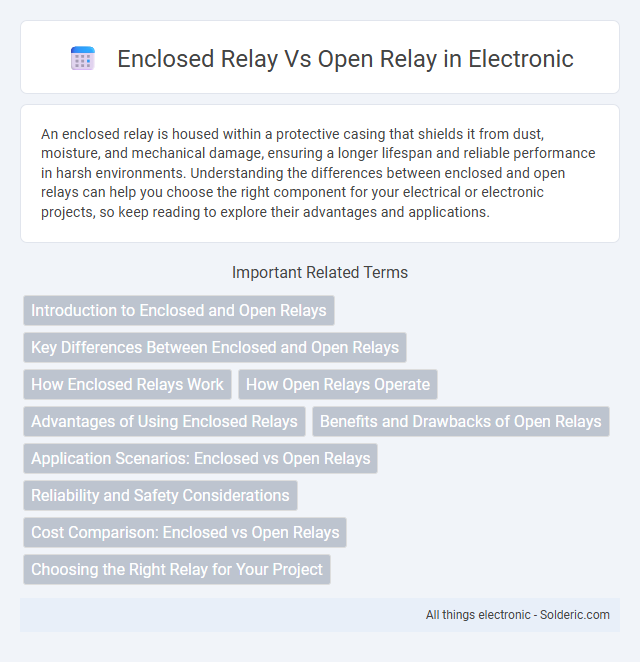An enclosed relay is housed within a protective casing that shields it from dust, moisture, and mechanical damage, ensuring a longer lifespan and reliable performance in harsh environments. Understanding the differences between enclosed and open relays can help you choose the right component for your electrical or electronic projects, so keep reading to explore their advantages and applications.
Comparison Table
| Feature | Enclosed Relay | Open Relay |
|---|---|---|
| Protection | Encased in a protective housing, dust and moisture resistant | No protective housing, exposed to environment |
| Durability | High durability and longer lifespan | Lower durability due to exposure |
| Application | Industrial, automotive, outdoor applications | Controlled indoor environments |
| Maintenance | Low maintenance required | Higher maintenance and cleaning needed |
| Cost | Higher cost due to enclosure and protection | Lower cost, simpler design |
| Size | Generally bulkier due to enclosure | More compact size |
Introduction to Enclosed and Open Relays
Enclosed relays are housed within a protective casing that shields the internal components from dust, moisture, and physical damage, ensuring reliable operation in harsh environments. Open relays, on the other hand, lack this protective enclosure, making them more susceptible to contamination and mechanical wear but allowing for easier inspection and maintenance. Choosing between enclosed and open relays depends on your specific application requirements, including environmental conditions and maintenance preferences.
Key Differences Between Enclosed and Open Relays
Enclosed relays feature protective casings that shield internal components from dust, moisture, and mechanical damage, enhancing durability and reliability in harsh environments. Open relays lack such enclosures, making them more vulnerable to external contaminants but allowing easier inspection and cooling. Your choice between enclosed and open relays depends on the application's environmental conditions and maintenance requirements.
How Enclosed Relays Work
Enclosed relays operate by housing the electromagnetic coil and contacts within a sealed casing, protecting the internal components from dust, moisture, and other environmental contaminants. This design ensures reliable switching by maintaining consistent contact performance and reducing the risk of corrosion or mechanical failure. You can expect enhanced durability and longevity in applications where environmental protection is critical.
How Open Relays Operate
Open relays operate by accepting and forwarding email messages from any sender to any recipient without authentication or restriction, allowing unauthorized users to relay spam or malicious content. These relays function as intermediaries that do not verify the origin of the emails, making them vulnerable to exploitation by spammers and increasing the risk of blacklisting. In contrast, enclosed relays implement strict access controls and authentication mechanisms, preventing unauthorized use and ensuring secure email transmission.
Advantages of Using Enclosed Relays
Enclosed relays offer superior protection against dust, moisture, and other environmental contaminants, enhancing their durability and reliability in harsh conditions. These relays provide safer operation by preventing accidental contact with electrical components, reducing the risk of short circuits and electrical shocks. You benefit from longer service life and consistent performance in industrial or outdoor applications where exposure to elements is a concern.
Benefits and Drawbacks of Open Relays
Open relays allow emails to be forwarded through third-party servers without authentication, increasing the risk of spam and abuse which can lead to blacklisting of the server's IP address. They offer the benefit of ease in message relay and broader email distribution but compromise on security and email reputation. The primary drawback is vulnerability to exploitation by spammers, resulting in compromised server integrity and reduced deliverability of legitimate emails.
Application Scenarios: Enclosed vs Open Relays
Enclosed relays are preferred in harsh industrial environments where protection from dust, moisture, and mechanical impact is critical, making them ideal for manufacturing automation and outdoor equipment. Open relays, offering better heat dissipation and easy inspection, are commonly used in controlled environments such as laboratory equipment and low-risk electronic circuits. Selecting between enclosed and open relays depends on specific application needs related to environmental exposure, maintenance access, and thermal management.
Reliability and Safety Considerations
Enclosed relays provide enhanced reliability by protecting internal components from dust, moisture, and mechanical damage, ensuring consistent operation under harsh environments. Open relays, lacking protective casing, are more susceptible to environmental contaminants that can cause contact degradation and operational failures, reducing overall safety. Enclosed relay designs minimize electrical hazards by preventing accidental contact, making them preferable for applications demanding high safety standards.
Cost Comparison: Enclosed vs Open Relays
Enclosed relays generally have a higher initial cost due to their protective casing, which guards against dust, moisture, and mechanical damage, enhancing reliability and lifespan in harsh environments. Open relays, being less expensive upfront, lack this protective enclosure, making them more vulnerable to environmental factors that may lead to increased maintenance and potential replacement costs over time. Your choice between enclosed and open relays should consider these long-term operational expenses alongside the initial investment to optimize overall cost efficiency.
Choosing the Right Relay for Your Project
Enclosed relays offer enhanced protection against dust, moisture, and mechanical damage, making them ideal for harsh or industrial environments, while open relays provide easier inspection and cooling but are more vulnerable to environmental factors. Your choice depends on the operating conditions and reliability requirements of your project. Prioritizing enclosed relays ensures longer lifespan and consistent performance in challenging settings.
Enclosed relay vs open relay Infographic

 solderic.com
solderic.com